Should you use Google Trends for SEO? You may not be sure because you haven’t tried it yet. Not a problem, in this article, we’ll show you some path-breaking SEO techniques using this tool.
Using Google Trends for SEO
It is a free online tool from Google to identify search and keyword trends. It’s like a master key that can unlock the hidden SEO treasure for your website. Just know how to use it and choose the right approach that can deliver the results you expect.
Spend 15 minutes of your time and you’ll get the hands-on tips. We’ll share some good techniques for free to make you learn how to use Google Trends to improve the SEO of your blog. Here is a list of areas that we’ll cover in this article.
- What does the Google Trends tool do and how can it help?
- What are the Google Trends tips & tricks to help in keyword research?
- How to use Google Trends to improve the SEO of your blog?
Before you dive in to read about Google trends, read some evergreen techniques to improve SEO. You can improve the response time and reduce the delay in rendering for your website by following these tips.
Must Read –
How to Increase Domain Authority?
Use Grammarly to Improve Your English Writing
Checkout the Best Google AdSense Plugins
If you are a blogger and have been thinking about how to use Google Trends to improve the SEO of your website then this is the guide for you. So let’s go and get started.
What is Google Trends and how can it help?
Google Trends is a free tool from Google that shows how much people search for a term compared to all searches worldwide and in different languages. It lets you look at trends over time and presents them in easy-to-understand graphs.
For bloggers, Google Trends is handy for various SEO jobs. You can find good keywords, compare them, search for popular topics, check out what your competition is doing, discover content ideas, and build links.
Use it for keyword research and improve SEO
Using Google Trends is easy and makes sense. You go to its website, type in a word or topic, and press enter. There are different choices on the Google Trends page. Let’s learn how to use them to get what we want.
a) Query box
We choose to start with the query box because you can’t ignore the power of this slimy input element. You just need to harness its full potential to attain the optimum efficiency.
- If you want to test the significance of a particular keyword in the present scenario and need to assert its consistency from past usage. Just put it in the query box without tinkering with the default options. It’ll show you the keyword trend of the default timeline and will give you a clear picture.
- Next, you must note that you can at most use up to five keywords or keyword groups at one time, with up to 25 words in each group. Follow the below example.
- web hosting + WordPress + theme (group A).
- WordPress plugin + Yoast + SEO (group B).
- social media + content promotion (group C).
The + sign instructs Google that you like to group searches for web hosting or WordPress or theme.
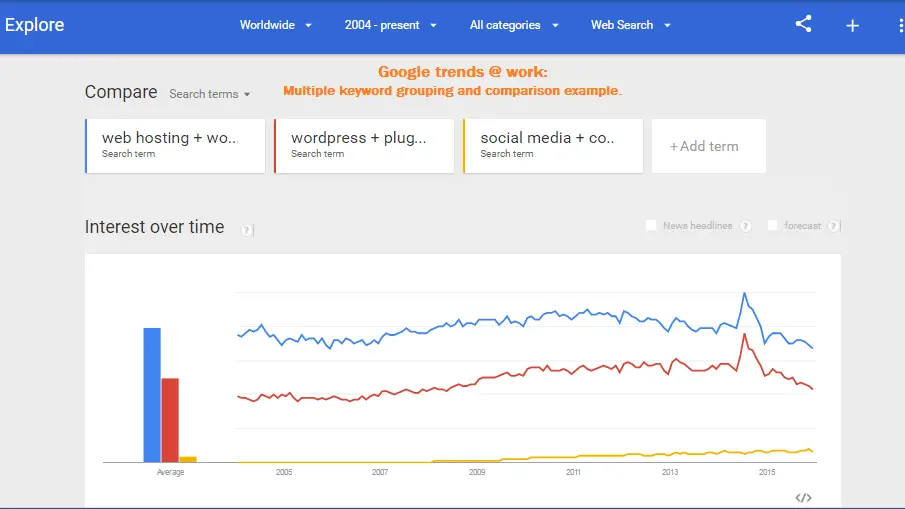
Let’s now check out the other options that are present on the Google Trends screen.
b) Lookup zone
You can limit your hunting zone by choosing the default, country-wide, or state, or you can be precise by selecting a city.
c) Result timeline
You can filter timeline by choosing from a predefined set (past hour, past day, past 7 days, past 30 days, or past 12 months, etc.). If none of it suits you then selecting a custom period is also worth an option. The default timeline dates back to 2004, which does the job in most of the cases.
d) Category
You can also cut down the terms and search volume to your desired category. With this feature, you can observe specific trends and reveal fresh themes.
e) Target engine
Another important filter is there to refine your results based on Web, News, Video, and Shopping. It leaves you with greater flexibility in selecting the brand and vertical. It intends to give you results closer to your expectations.

If you refer to the trend chart of the sample that we’ve used above, you can find a more popular keyword. The data is pretty much what we expected. You can sense the clear winner is the blue line i.e. the combo of web hosting and WordPress.
Use Google Trends to improve the SEO
So, how come all this data can help us in SEO? Here are some ideas for better content creation, niche selection, and more SEO stuff where you can use Google trends insights.
To spot the right niche
A niche market is a market entity on which a specific product is focusing. You can further classify a market into logical market sections with specific interests and demographics. For example, the fashion niche is huge. Within the fashion niche, you can find its subsets like the ones which are in skin care products, hair loss products, weight loss, artificial jewelry, and more. You can even further drill them down into tier-2 niches such as “hair removal products” or “surgical hairs”. Some of these tier-2 niches can be highly profitable. So, it’s worth doing some analysis to determine if the one you are passionate about has profit potential.
Here we’ve run an illustration of 5 different niche segments and any one of you can easily pick the segment that has a higher market share. But it’s not always advisable to go by the numbers instead you’ve to choose the niche diligently and pick the one that strikes you.
For the illustration, we’ve used the following niche segments.
- Tech Blog
- Travel Blog
- Fashion Blog
- Java Blog
- Android Blog
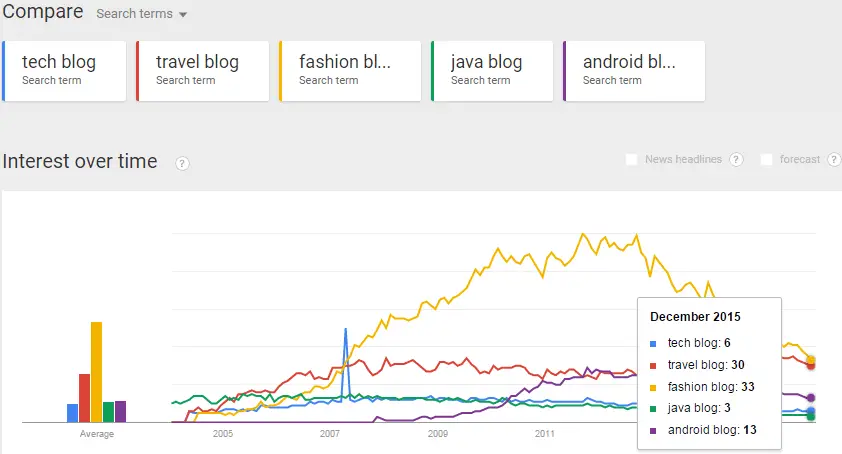
And as we’ve mentioned earlier you can narrow your search by grouping specific keywords to find out the niche of your choice. And you can filter out based on location if you are planning to enter into the travel segment. Also, you can analyze the top/rising topics and queries before finalizing the selection because it’ll help you improve the SEO for your blog.
Search for profitable keyword
We’d earlier mentioned that the Google Trends tool represents the search interest relative to the highest point on the chart not with the real traffic. So it is best to use Google Trends alongside the keyword planner. Google Trends will provide you with the leading words. You can verify them with the planner tool.
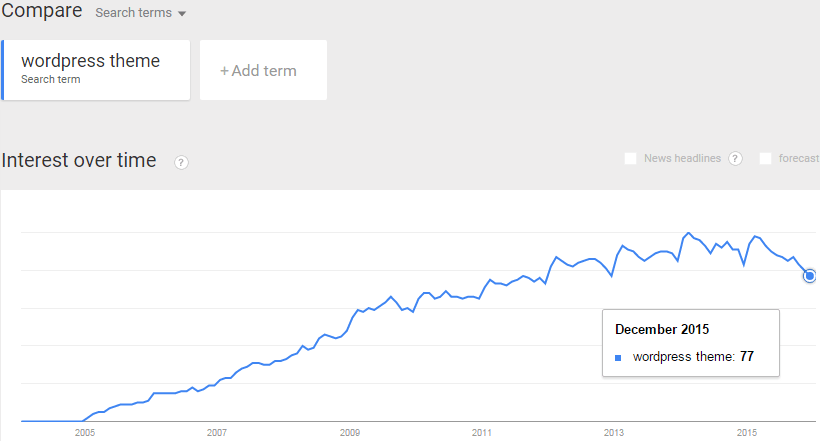
To understand, what is the major driver of traffic or how can it help to improve SEO? You may need to review the “Related searches” section from the Google Trends screen. Here, we’ve executed a Google trends query for the “WordPress theme”. From the trend chart, you can see the steady rise in the keyword interest. But people are looking for a “free WordPress theme” or the “best WordPress theme”.
Please review the attached screenshots for a detailed view.
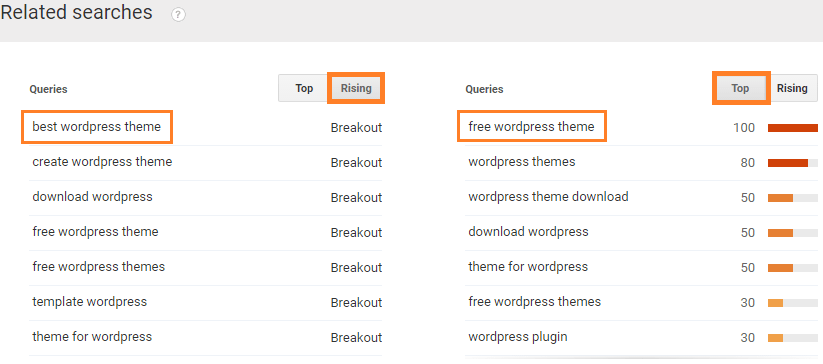
Improve SEO by localizing search
For this topic, we’ve input the “blog” as the search term in the Google Trends query box. Here we want you to learn that Google Trends filters the results by location and subdivides it further into towns or cities. As you can see below, the term has partial interest across the whole U.S., whereas most of it is coming from Sterling and Seattle.
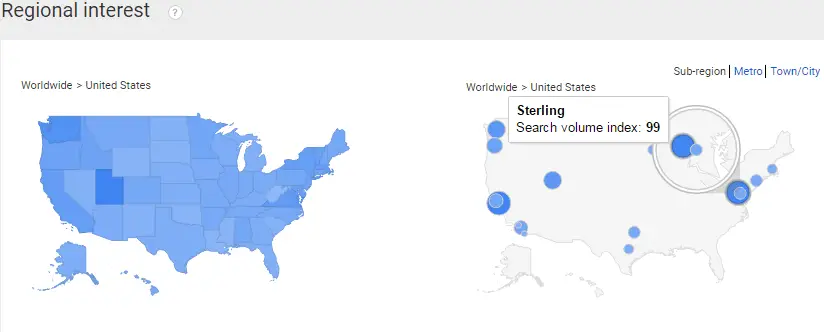
Inherit content ideas from charts
Top Charts is another little-known feature of Google Trends. But it is one of the best resources for producing content ideas that you would like. You can refer to the below snapshot of Top Charts where Flipkart and Amazon terms are trending. Click the “Explore in-depth” icon next to these terms for a quick summary.
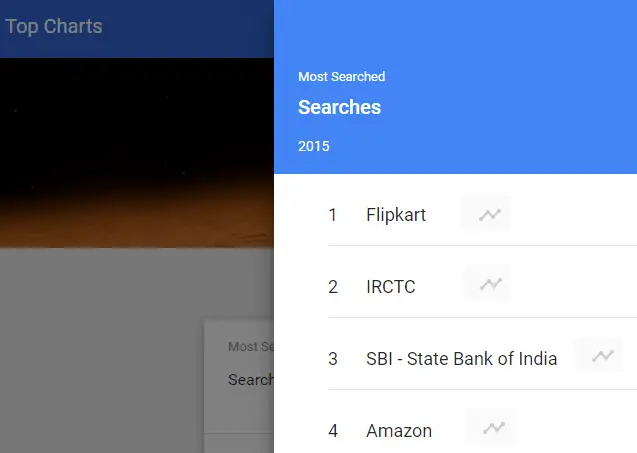
Seems like an article about Flipkart and/or the Amazon affiliate would grab the interest of the readers. Next, you should remember whenever you tend to explore a particular term. And the term “Breakout” appears under “Rating”, it indicates that the phrase has sprung up by +5,000 percent.
Spot viral video content
No doubt, the killer textual content, and the popular keywords play a major role in boosting the SEO of any website. But if you can locate and link to or produce viral video content related to your niche that would be the best thing you could do for improving your SEO.
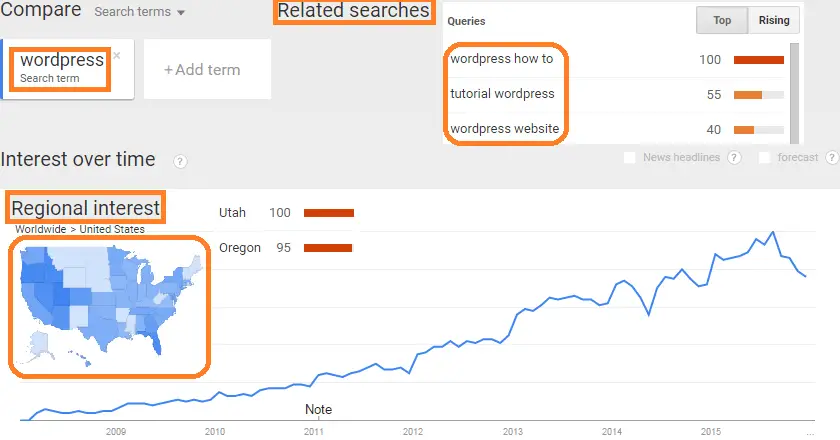
For this illustration, we’ve used the “WordPress” as the search term. The trend results are unprecedentedly steady for this term from the year 2009 and onwards. To produce the best result, we’ve switched our engine type to “YouTube Search” and selected the region as “United States”. Now observe the “Related Searches” section as you use this data for video optimization.
- Here, you have the right set of topics which you can use to choose a great title for your video.
- From the “Queries” subsection, pick the most popular keywords that you can add to your video meta description as well as apply them as tags.
Live Blogging to gain on SEO
Real-time live blogging is a new way for real-time content delivery. Live blogging is just posting regular updates to your website as the event is taking place, rather than blogging about it after the fact. It can be a very valuable resource to your readers if done right. Let’s now see how you can use Google Trends to help in real-time live blogging.
- Google Trends makes your content (trends chart) embedded in your page. which helps you get the best search engine optimization.
Note: You can do that by using the Embed button given beneath the chart. Clicking it would generate the HTML code you need to add to your site. - It also allows you to subscribe to the hottest topics as and when they occur. It would be more useful when you have G+ configured on your mobile phone and pay attention to the live alerts.
- It offers a Trending Searches feature which you can use to choose a topic from and blog in real-time.
- You can also dig into a particular event using the explore in-depth option of trends to list out the top keywords.
- If you don’t have time to publish, then you have the option to instantly share the live trending content on social media like Twitter, Facebook, or G+.
Brand monitoring
Brand monitoring is like keeping an eye on the internet and media to understand what people think about a company and its stuff. It helps see how the public and customers feel about the brand. It’s all about checking how well the brand is doing and what people are saying.
If you are a website owner then there is one factor that you should care about, it is the Domain Authority of your site. It’s one of the best online indicators that makes your website shine out of the crowd from the sites in your niche. We’ve also put in a lot of effort in a planned manner to improve the DA of our blog.
Now coming back to the current topic, we insist that you should keep a tab on your brand status more frequently. And you would have understood by now that the Google Trends tool is good at tracking. It can tell you how your brand is faring against your competitors. For example, let’s plug in some popular social media platforms as search terms. We used “Reddit”, “Pinterest” and “Google+” for this sample. We didn’t add “Facebook” and “Twitter” into the sample because that would have turned the trends in favor of the two biggies. And that would have put us off the topic.
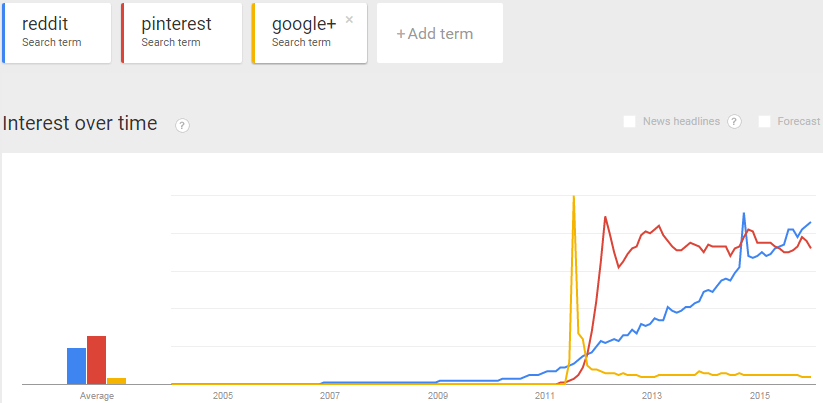
Now, just see the big spike in searches for “Google+” during 2011-2013. Impressed, oh not exactly, because if you compare it with the other two (“Reddit” and “Pinterest”), you’ll get to learn that a spike in searches doesn’t always translate into success for a company or website.
Quick Summary
We hope the above tips and tricks using Google Trends will improve your blog’s SEO, just like they did for us. Using these ideas can bring more visitors to your blog. A big thanks to Google for providing this tool for free. It helps keep your blog active and makes your posts more relevant. If you haven’t used this tool for SEO yet, you should at least try.
Before we close for the day, we appeal to the readers to share this post with their friends and on the social media platforms that interest them most.
Keep Learning.
Team TechBeamers









